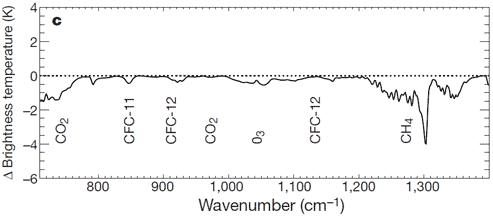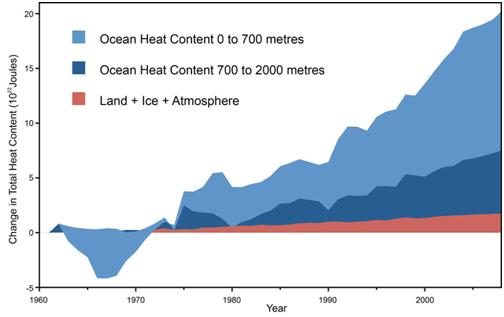I never really enjoyed statistics classes at university, but it was a compulsory subject and so I had no other choice. While I’ve since found Microsoft Excel can do all the hard work I was forced to learn to do manually, there’s one thing it can’t cover off that I was taught about in Quantitative Methods 1: correlation doesn’t equal causation.
But that doesn’t prevent plenty of people from incorrectly or even mischievously trying to draw correlations and then claim one caused the other. So it is with the recent claim publicised by the likes of News Ltd columnists Andrew Bolt and Graham Lloyd and seized upon by Liberal MP Cory Bernardi that chloroflurocarbons or CFCs ‘are the real culprit in global warming’.
To explain this principle with an example, in studying a range of sales data you find ice cream sales go up at the same time as beer sales during summer. Just because they happen to both go up at the same time doesn’t therefore mean that eating ice cream is making people become incredibly thirsty for a beer (although I do think there is a legitimate causal link between beer and souvlaki/kebab sales).
If you thought this was the case however, to be thorough you’d want to test the relationship by physical observation of the people eating ice cream to see what they did after consumption. You’d then realise that the ice cream was in fact being eaten by children under the age of 12, who don’t tend to drink much beer. And the beer drinkers weren’t eating all that much ice cream, but did seem to have an odd fetish for souvlakis at 2am in the morning.
This argument that CFCs are the real culprit is based on a new paper by Qing-Bin Lu published in the peer-reviewed International Journal of Modern Physics B. This paper finds that the concentration of CFCs in the atmosphere and changes in cosmic rays from the sun can be better correlated via some creative maths to changes in surface temperatures over the past century than CO2. Therefore global warming is about to end because CFCs are now being phased out.
The interesting thing is that this is extremely similar to arguments he ran in earlier papers published back in 2009 and 2010. There are good reasons for why these papers didn’t make an impact on scientific thought back then and why this latest paper will suffer the same fate — because he’s failed to adequately explain causality, and the correlation is also dodgy.
A number of CFCs, in addition to causing the hole in the ozone layer, are also powerful greenhouse gases, so there’s some causal link at work here. But they aren’t the only gas in the atmosphere that we know traps heat. Greenhouse gases act to trap heat by absorbing particular wavelengths of energy, in particular thermal infrared, preventing them escaping into space. The interesting thing is each gas has its own characteristic set of wavelengths that it will absorb which can help us in identifying and measuring their respective impact.
Satellites from NASA and Japan have been measuring outgoing wavelengths of radiation from Earth now for several decades. These measurements (illustrated below) show that there has indeed been a reduction in the outgoing radiation at the wavelengths absorbed by CFCs over this time. But so have those wavelengths absorbed by CO2 and CH4 (methane).
Change in outgoing spectrum from 1970 to 1996 due to trace gases

This has been backed by other studies looking at surface measurement of different wavelengths of infrared energy. So if CFCs are solely to blame, then what is happening to all that infrared radiation being reflected back to earth by CO2 and CH4? Lu doesn’t address this.
As Skeptical Science observed on Lu’s past and present work:
“The physics of how CFCs might impose such a strong radiative forcing are not addressed. Lu mentions that the radiative forcing from CFCs haven’t been directly measured, then moves onto statistical correlations. In fact, the greenhouse effect from CFCs have been quantified from surface observations of the infrared radiation spectrum (Evans 2006). The observed results are broadly consistent with model predictions [of the IPCC] of greenhouse forcing.”
When Lu made similar claims in a 2010 paper it was pulled to pieces in a critique published in the journal Atmospheric Environment which concluded:
“We further demonstrated that the methods of analysing ozone and global temperature data used by Lu (2010a) which are based solely on correlations of parameters, are not conclusive to explain the complex processes both of ozone depletion and surface temperature development. Thus, meaningful predictions based on the correlation of EESC [which stands for equivalent effective stratospheric chlorine — CFCs break down into chlorine once in the stratosphere] and temperature anomalies cannot be drawn. The strong conclusions for climate models put forward by Lu (2010a) do not have a physical basis.”
What Lu has failed to do, in conjunction with an array of amateur climatologists, is to consider that the earth is surrounded by a large amount of blue stuff we call the ocean. As the team at Skeptical Science have pointed out, the oceans are accumulating a huge amount of heat — vastly more than the earth’s surface and atmosphere (as illustrated below). Those who like to think that global warming is over by cherry-picking surface temperature data since 1998 ignore the warming of the ocean.

Source: Nuccitelli et al. (2012)
While Lu’s work appeared in a peer-reviewed journal, the thing is, just like everything else in life, they aren’t all of equal quality. The alarm bells should have been ringing for journalists by the fact the paper was published in an academic journal largely ignored by most of the academic community. This should ideally prompt a bit of cross checking to assess whether the claims stack up which would have found that Lu has made these claims in the past and they have been found badly wanting.
This article has drawn heavily on research published by skepticalscience.com. To see their more detailed analysis of this issue click here.
* This article first appeared at Climate Spectator.







If it is BS, why give it column inches? Your constant and repetitive focus on Bolt only serves to give his inanities oxygen that relies on the old adage ‘any publicity is good publicity’.
I subscibed to Crikey in the belief that it offered a responsible position in the fourth and fifth estate and find that belief being challenged on a daily basis.
Crickey would have more credibility if they re-instated their Enviromental heading and file category.
Actually I found this quite good as it outlines the flaws in the CFC research in an academic way that reflects a consensus, it’s important that we can contrast what the scientific community thinks of a particular study with how it’s presented in Australia’s media.
Typical overkill.
>>While Lu’s work appeared in a peer-reviewed journal, the thing is, just like everything else in life, they aren’t all of equal quality. The alarm bells should have been ringing for journalists by the fact the paper was published in an academic journal largely ignored by most of the academic community.<<
International Journal of Modern Physics B is your typical obscure science journal read by those who work in the field it covers – namely Condensed Matter Physics; Statistical Physics; Applied Physics.
A quick look at the editorial board clearly shows that JMPB is a highly respectable publication in its area of science.
Peter Fulde
Max Planck Institute for the Physics of Complex Systems
Nöthnitzer Str. 38, 01187 Dresden, Germany
Rongjia Tao
Department of Physics
Temple University
1900 N. 13th Street
Philadelphia, PA 19122-6013
USA
Yu Peng Wang
Institute of Physics
Chinese Academy of Sciences
P O Box 603
Beijing 100190
People's Republic of China
Editorial Board Members
N N Bogolubov, Jr (Steklov Mathematical Institute, Russia)
C W Chu (University of Houston, USA)
M Di Ventra (University of California, San Diego, USA)
C M Falco (University of Arizona, USA)
A Fujimori (University of Tokyo, Japan)
A Furusaki (RIKEN (The Institute of Physical and Chemical Research), Japan)
M L Ge (Nankai Institute of Mathematics, China)
L Glazman (University of Minnesota, USA)
J D Guo (Chinese Academy of Sciences, China)
S-Y Han (University of Kansas, USA)
P Ho (National University of Singapore , Singapore)
B Hu (University of Houston, USA)
J-P Huang (Fudan University, (China))
G-J Jin (Nanjing University, China)
K J Jin (Chinese Academy of Sciences, China)
X Ke (Physics Department, Beijing Normal University, China)
J Klafter (Tel Aviv University, Israel)
V Korepin (State University of New York, USA)
H C Ku (National Tsing Hua University, Taiwan)
T-K Lee (Academia Sinica, Taiwan)
B W Li (National University of Singapore, Singapore)
W X Ma (University of South Florida, USA)
D C Mattis (University of Utah, USA)
A Mookerjee (S N Bose National Center for Basic Sciences, India)
C-Y Mou (National Tsing Hua University, Taiwan)
M Mueller (Georg-August Universität, Germany)
Y Oono (University of Illinois at Urbana-Champaign, USA)
V Pokrovsky (Texas A & M University, USA)
W-T Pong Philip (The University of Hong Kong, China)
C N R Rao (Jawaharlal Nehru Centre for Advanced Scientific Research, India)
M Rasetti (Politecnico di Torino, Italy)
A V Razumov (Institute for High Energy Physics, Russia)
S Sen (State University of New York at Buffalo, USA)
A Serpenguzel (Koc University, Turkey)
Y Shi (Fudan University, China)
C-H Sow (National University of Singapore, Singapore)
N Stefanou (University of Athens, Greece)
M Stone (University of Illinois, USA)
H B Su (Nanyang Technological University, Singapore)
M Suzuki (Science University of Tokyo, Japan)
R-B Tao (Fudan University, China)
C S Ting (University of Houston, USA)
Jian Wang (The University of Hong Kong, China)
Jiao Wang (Xiamen University, China)
X G Wen (MIT, USA)
Z-Y Weng (Tsinghua University, China)
T Xiang (Chinese Academy of Sciences, China)
X D Xiao (The Chinese University of Hong Kong, China)
H X Xu (Chinese Academy of Sciences, China)
Z C Ou-Yang (Academia Sinica, China)
Y G Yao (Beijing Institute of Technology, China)
N-C Yeh (California Institute of Technology, USA)
L Yu (Institute of Theoretical Physics, China)
F-C Zhang (The University of Hong Kong, China)
S C Zhang (Stanford University, USA)
Z X Zhao (Chinese Academy of Sciences, China)
X J Zhou (Chinese Academy of Sciences, China)
Meanwhile, there are hundreds if not thousands of these obscure science journals out there. And almost all are ignored by the rest of the so called academic community – lets not forget that over specialisation is one of the greatest obstacles to science today.
There is no need to dismiss the publication as lightweight, of low value or of dubious quality simply for publishing something that doesn't fit the consensus view. Virtually every major breakthrough in science came from people who went against the prevailing thinking to develop new ideas about the physical world. Just read the history of ice age science or the theory of evolution – let alone "climate science" itself which took many years to become an accepted area of contemporary science.
Challenge the science not the publication.
An interesting article with solid information.
It is not in the data that I dispute the articles, either relevanc, or its’ scientific veracity, but the leveraging of Bolt et al and their puerile rebuttals that I find unbecoming.
Tristan has delivered a well supported and argued series of articles for the past many months without giving Bolt and his ilk oxygen.